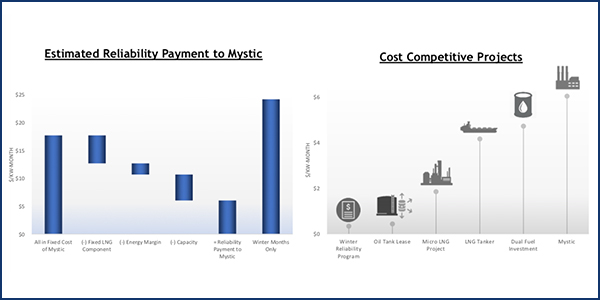By Michael Kuser
The New England Power Pool Markets Committee met last week to discuss ISO-NE’s proposed Energy Security Improvements (ESI), but the sense of urgency to act has lifted after FERC extended an October deadline by six months.
Todd Schatzki of Analysis Group was joined by ISO-NE economist Christopher Geissler to present an analysis of the impacts of ESI. Pressed by stakeholders on how the study would move forward with the deadline now pushed out to April, Schatzki said the effort will benefit from the additional time — but that his firm is not expecting any delay in its work.
Geissler said that although the energy security improvements team would no longer be “going at breakneck speed,” it was committed to getting out the best design as soon as possible.
The New England States Committee on Electricity (NESCOE) filed the motion for the delay, asserting that the complex market design effort in the region was being unduly rushed. (See FERC Extends ISO-NE Fuel Security Filing Deadline.)
Forward Market
Rebecca Hunter, Calpine senior analyst of government and regulatory affairs, presented again on the company’s proposed Forward Enhanced Reserves Market, expanding on its current position and suggesting modifications to ISO-NE’s proposal. She said Calpine will use the extension to spend more time on draft Tariff language.
“In terms of the need to run RAA [resource adequacy analysis], I do see it happening as often as you would award for EIR [energy imbalance reserves],” Hunter said. “If you think about it, with the ISO awarding resources for EIR, the operators are not going to have any information about those resources being awarded, so when they go to decide who they should commit under the RAA process, they’re going to be starting down from the bottom of the stack.

Calpine’s Forward Enhanced Reserves Market (FERM) is a market design intended to pay all fuel-secure resources equally. | Calpine
“There’s a chance that maybe they’re picking up that same EIR resource in the RAA process, and I do identify that as getting paid for the same thing, that has been awarded twice, or there’s also a chance that they’re running a completely separate resource,” she added.
Geissler led a discussion of the framework for developing a forward component to the ESI design.
“I don’t know how we’d get the linkage between the forward sale of fuel and the expected obligation in the [day-ahead] market, or how those settle,” Geissler said. “For example, if there is no linkage, there may be concerns about how resources can be compensated for fuel through a couple different mechanisms, but at the same time, without a spot market that looks a lot like this, it’s not necessarily clear to me how to link the two in a sensible way.”
Stakeholder Amendments
Christina Belew of the Massachusetts attorney general’s office presented three amendments to the ESI proposal, each to be voted on separately by the MC:
- Restrict use of generation contingency reserves, replacement energy reserves (RER) and EIR to winter months; and require impact analysis and NEPOOL stakeholder process before implementing ESI year-round.
- Limit use of 90-minute and 240-minute RER options year-round.
- Add a sunset provision to the proposed energy security improvements to trigger review of program need and efficacy.
Belew said her office was no longer going to proceed with its forward stored energy reserve proposal — a seasonal auction format for stored energy options — because after modifications were made to address stakeholder concerns, it no longer met the attorney general’s original objectives of providing the most efficient solution at least cost to consumers, fairness to all resources and responsiveness to future changes in resource mix.
NESCOE Director of Analysis Jeffrey Bentz also presented four possible amendments, including restricting EIR and RER to the winter months, but said the group is “considering these as one set of potential amendments, not four separate amendments.”
Another amendment would implement a must-offer requirement for resources with capacity supply obligations, while another would increase by 25% the strike price for ISO-NE’s proposed hourly energy call options — and create two options.
“Even with these amendments, analysis suggests that ESI as amended would be unlikely to fully solve the emerging concerns around market power mitigation but would be a step in the right direction,” he said. “We may decide to separate, eliminate or modify these based on today’s discussion and those going forward.”
David Errichetti of Eversource Energy briefly presented an amendment to address the company’s concern that the RTO’s interim Inventoried Energy Program would overlap with energy security improvements for winter 2024/25.
ISO-NE has promised to develop netting rules to address paying for both programs but has presented nothing yet, so NEPOOL is being asked to approve these rule changes without knowing if the netting rules will avoid paying twice for winter 2024/25 operations reliability, Errichetti said.
Robert Laurita, on behalf of the Connecticut Public Utilities Regulatory Authority and the Department of Energy and Environmental Protection, presented their amendment to the Tariff language concerning quarterly certification of the competitiveness of the energy call option offers in the day-ahead market and the related clearing prices.
Pending consideration of an amendment from PSEG Long Island, the RTO on Wednesday postponed a vote on Tariff changes to clarify that a resource retained for fuel security will only be retained until the end of the fuel security need and no longer than the two-year period allowed by FERC. The MC will vote on the matter at its Sept. 18 meeting. (See “Time Limit on Fuel-security Resources,” NEPOOL Markets Committee Briefs: July 30, 2019.)


